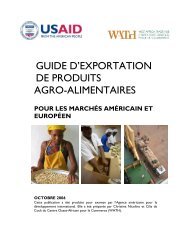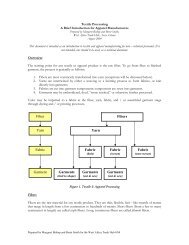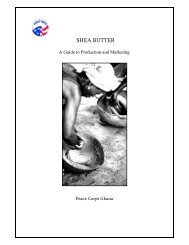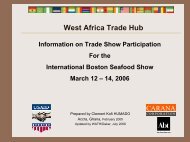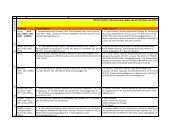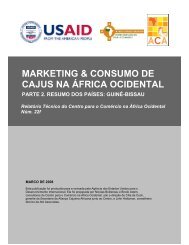A Value Chain Analysis of the Cashew Sector - AGOA Export Toolkit
A Value Chain Analysis of the Cashew Sector - AGOA Export Toolkit
A Value Chain Analysis of the Cashew Sector - AGOA Export Toolkit
Create successful ePaper yourself
Turn your PDF publications into a flip-book with our unique Google optimized e-Paper software.
<strong>Value</strong> chain addition regarding cashews is mainly realised through processing and packaging activities.<br />
Th ere are diff erent processing steps involved, mostly carried out by diff erent actors and, again, mostly<br />
outside Ghana. As for RCN originating from Ghana, <strong>the</strong> vast majority are exported to India, where <strong>the</strong>y<br />
are converted into plain kernels which are <strong>the</strong>n exported in bulk to markets in developed and emerging<br />
countries. Th ere, fur<strong>the</strong>r processing takes place with regard to roasting, salting/seasoning, packaging,<br />
and labelling/branding.<br />
Th e cashew industry in Ghana currently boasts 12 processing companies, with a total installed<br />
capacity <strong>of</strong> 2,137 t per year. Th e only medium processing company is Mim <strong>Cashew</strong> Products, which<br />
has an installed capacity <strong>of</strong> 1,000 t per year and, as <strong>the</strong> name implies, is located in Mim. Th e remainder<br />
are small enterprises with an installed capacity ranging from 10 to 250 t per year. Th ese companies<br />
process kernels for export and for secondary processing around Accra.<br />
Th ere are 21 kernel roasting companies operating in diff erent parts <strong>of</strong> <strong>the</strong> country: 17 in <strong>the</strong> Greater<br />
Accra Region, three in <strong>the</strong> Brong-Ahafo Region and one in <strong>the</strong> Eastern Region. Th e kernels <strong>the</strong>y roast<br />
are sold in hotels, restaurants and supermarkets. Th e “<strong>Cashew</strong> Processing, Marketing and Consumption<br />
in West Africa” (USAID 2007) study concludes that <strong>the</strong> average retail price <strong>of</strong> locally processed cashews<br />
is highest in Ghana and Côte d’Ivoire – higher even than that <strong>of</strong> imported Asian cashews. If prices<br />
cannot be reduced signifi cantly, <strong>the</strong> local market for cashews will be dominated by imports.<br />
It has been estimated that <strong>the</strong> cashew sub-sector can contribute to pro-poor economic growth by<br />
gene ra ting over 200,000 permanent and seasonal jobs, particularly for farm labourers and intermediaries<br />
(<strong>Cashew</strong> Development Project, 2008). Fur<strong>the</strong>rmore, marketing, distribution and processing<br />
<strong>of</strong> RCN <strong>of</strong>f er more than 5,000 permanent and seasonal jobs annually in <strong>the</strong> cashew industry as it<br />
now stands (CDP 2009a).<br />
Th e marketing <strong>of</strong> RCN is currently one <strong>of</strong> <strong>the</strong> most critical issues <strong>of</strong> concern for farmers. RCN are<br />
marketed between February and May <strong>of</strong> each year, and without much structured organisation to <strong>the</strong><br />
underlying process. Basically, RCN marketing companies visit known cashew farming communities<br />
individually to ei<strong>the</strong>r purchase RCN directly, or to collect <strong>the</strong> RCN already purchased at an agreed<br />
price by <strong>the</strong>ir locally commissioned people and local marketing agents. Th us, <strong>the</strong> marketing channel<br />
consists <strong>of</strong> producers, village merchants, or agents and exporters. Since this is an activity restricted to<br />
only four months in <strong>the</strong> year, <strong>the</strong>re are no exclusive traders for raw cashew nuts. Often, <strong>the</strong>re are<br />
intermediaries or agents acting between traders, exporters and processing companies who provide information<br />
services and make deals. Th is has resulted in middlemen playing an important role in <strong>the</strong><br />
marketing <strong>of</strong> nuts, and <strong>the</strong>reby reduced <strong>the</strong> margin or dividends accrued by cashew farmers.<br />
Prices vary widely from place to place, from season to season, and even within <strong>the</strong> same season.<br />
Th e producer price is a function <strong>of</strong> many factors, <strong>the</strong> most important <strong>of</strong> which are international cashew<br />
supply and demand dynamics, domestic market conditions, as well as <strong>the</strong> effi cacy <strong>of</strong> <strong>the</strong> regulatory<br />
mechanism and <strong>the</strong> tax/levy structure for <strong>the</strong> agricultural sector (personal comments by M. Das, 2009).<br />
Th e highest average farm gate producer price obtained so far was for <strong>the</strong> 2009 harvesting season.<br />
Th ere are a number <strong>of</strong> major bottlenecks hindering <strong>the</strong> development <strong>of</strong> <strong>the</strong> cashew value chain in<br />
Ghana. At <strong>the</strong> farmer level, <strong>the</strong>se would be: limited access to good planting material; a high incidence<br />
<strong>of</strong> pest infestations; weak extension services; and weak farmers’ associations. Meanwhile, limited access<br />
to working capital, an inconsistent supply <strong>of</strong> raw cashew nuts, inadequate transport facilities, and frequent<br />
fuel price fl uctuations that result in high transportation costs are major bottlenecks on <strong>the</strong> side<br />
<strong>of</strong> processing companies.<br />
9




